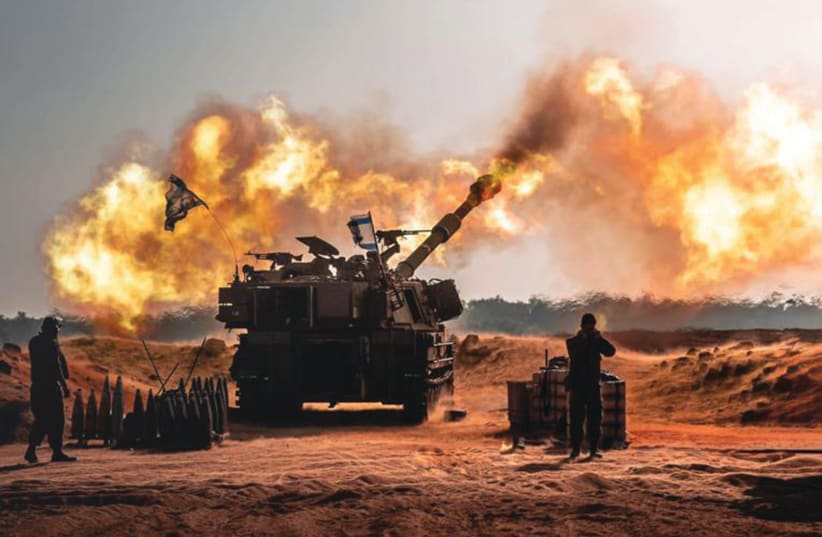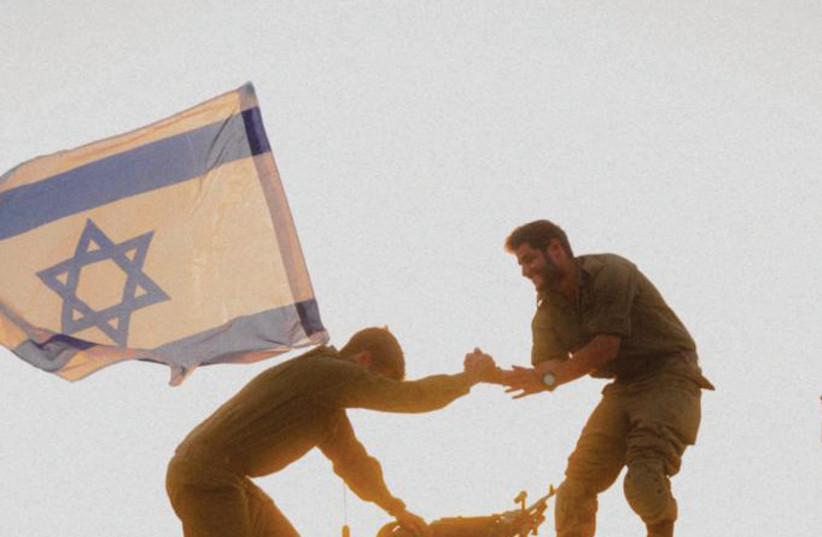
AN ISRAELI M109 howitzer fires artillery shells.
“Before the war we discussed the triangle, on one end the maneuver and the information and the fire,” Brig.-Gen. Yair Natans says.
He’s the IDF chief of artillery, and he is standing next to a board showcasing this triangle in an office in Tel Aviv at the Defense Ministry. As he points to the triangle, he explains how it applies on the battlefield.
“The main thing is to take this and all fire capabilities… so what we have been trying for the last decade is thinking about this triangle and trying to prepare and improve.”
IDF fire: How the military is changing
When the IDF uses the term “fire,” it means all the munitions that can be brought to the battlefield to be used against the enemy. This can include artillery but also can include airplanes firing missiles, or naval units.
This is part of how the IDF has changed over the last years, and it is also how Western militaries are changing. New technology enables units to be connected together. That means that infantry or tanks in the field are more connected to their battalion and brigades and, in turn, to their division; and together, they are more networked with artillery support and other fire support. What that means is that a lot of complex processes that might have taken time in the past to bring in a barrage of 155-mm. artillery shells to destroy an enemy threat can now be done faster.

SOLDIERS FROM the IDF Artillery Corps enjoy an evening at sunset with their M113 APC. (credit: IDF)
SOLDIERS FROM the IDF Artillery Corps enjoy an evening at sunset with their M113 APC. (credit: IDF)
This is where the triangle comes in. For a unit to maneuver, it needs information and needs to be supported by fire.
“What happened during the war is the [improvement of] the connection between them – the maneuver and the information – and choosing where to put the right kind of fire. I don’t care if it comes from the sky, land, or sea…. What I care about is the right time, right place… right size [of munition],” says Natans.
Natans enlisted in the IDF in 1996, during the Oslo [Accord] years. It was also the year of Operation Grapes of Wrath against Hezbollah. Natans came to the Artillery Corps in that year and eventually went through an officers’ course and took command of what is now the 282nd Fire Brigade. Back in the day, that unit was called the Golan Formation.
The Artillery Corps includes what we generally think of as artillery, meaning 155-mm. howitzers or cannons. It also includes a rocket array and the Hermes 450 Zik drones and the Sky Riders, which use smaller Skylark drones for surveillance. The artillery also uses special precision munitions.
The 282nd artillery unit is usually part of the IDF’s 36th Division, which has played a key role in the Gaza war since Oct. 7. It is now positioned in the North, preparing for possible escalation by Hezbollah.
A modern artillery unit like the 282nd includes M109 howitzers that fire 155-mm. shells. These are a very typical artillery shell used in Western countries. The M109 has been around for decades and is on treads, like a tank. It is slow and large. In addition, the 282nd uses multiple launch rocket systems, basically a unit that can fire rockets. It also has a unit that uses radar to detect where enemy fire is coming from so it can counter it.
Natans ran the Zik drone unit 5252, and then became chief of staff of the Fire Center of the Gaza Division. Later, he served in the Moran precision fire unit, from 2013 to 2015, and then ran the 282nd artillery unit before becoming the IDF’s chief artillery officer in July. He assumed his new position in September. This means he was just settling in to his new position when the war began.
He is from a community in the North that has been evacuated due to the Hezbollah threats. Israel evacuated around 80,000 people in October due to Hezbollah attacks. Natans is the son of Holocaust survivors. The massacre of Oct. 7 therefore resonates for him on multiple levels, as do the evacuations in the North. He describes the difficult feelings he faces due to the evacuation, especially the evacuation of his elderly father from the kibbutz in the North.
He describes how he came to his current position just 10 days before the war broke out, before Sukkot. “The war started as I was receiving this large organization… and from that moment beginning on Simchat Torah, my whole life has been this war, and there isn’t a unit that isn’t involved.”
This is because artillery plays a key role on both fronts, in the North and the South. In the South, it has supported the ground operation in Gaza to defeat Hamas. In the North, artillery is often used against Hezbollah sites, especially to retaliate for Hezbollah attacks. There have been 3,100 launches from Lebanon since October 8, when Hezbollah decided to support the Hamas attack.
He describes how artillery, or “fire units,” are now networked closely with the IDF battalions and brigades in the field. When soldiers need fire support, they receive it quickly. They also rely on strike cells that are part of their brigades to provide this support.
Natans says that the concepts by which the IDF has been working to improve its performance have worked well.
“We are doing more effective and relevant firing,” he says. There is also precision and accuracy. The units that provide this support include men and women.
He also discusses how reservists – around 300,000 were called up after the Oct. 7 attack – have played a key role.
“The reserve units have a special place in defending this country. Last Friday, I was at a dinner in one of the reserve units in the North,” he says. He describes meeting one reservist who had served, and then returned for a second 40-day stint in the army.
“Their honor is to have the ability to defend the country…. As an officer, one’s honor is to defend the country. It’s not just our job; it’s our privilege,” says Natans. He describes how the reservists went to their units, leaving families and work behind, and put it all aside to defend the country.
I asked Natans about his experience of Oct. 7. He speaks with compassion about the failure, the inability of the IDF to defend communities and residents on the Gaza border.
“As a commander, I can’t see it any other way.”
He thinks of “what we could have done…. We will investigate and find out.”
He also speaks with pride about the soldiers who rushed to defend communities.
It took time to deploy artillery units on Oct. 7, such as to move M109 howitzers south toward Gaza to bring the necessary fire power.
Nevertheless, once the artillery units were dug in around the borders of Gaza, they began firing shells into Gaza to destroy enemy sites.
In the future, the IDF will learn from Oct. 7 and be more prepared to have more fire units closer to the border. “I don’t see a situation where there are no ground fire capabilities in the future,” he says.
AS TECHNOLOGY becomes more common throughout the IDF, there is a lot of talk about “closing the circle” quickly to bring fire support into the fighting. This means also using more technological assistance that helps drones and armored vehicle sensors track things, and knitting those sensors in with artillery support.
“The technology is helping. We are not taking the man out of the loop, people using the technology. It may be very smart… the soldiers are working with the munitions all the time. There will always be a man in the loop,” says Natans. “There are a lot of decisions you need to make that the computer cannot do,” he says.
He also notes that the important designation of targets and needs for fire support come from the units in the field.
He says that while artillery can be used to pound an area from afar, the point today of artillery is not to soften up positions and just lob shells. “The point is not to attack a lot from afar. Rather, we want to strike from as close as possible.” This close proximity to friendly forces is something in which the IDF takes pride, bringing in airstrikes and fire support that is very close to IDF forces.
I asked whether these precision strikes close to IDF forces are due to the new technology.
“When I talk about the trust of the people, it’s not about the technology; it’s the trust they have in the people. Technology is not enough. What we have is cooperation between the air force and ground forces.”
I asked Natans whether the predictions of using technology to move faster and be more efficient in destroying any enemy capabilities have actually met the concept, as the IDF has waged six months of war in Gaza.
“The main thing this war in Gaza did was to clear out all the terrorist infrastructure… and you want to attack it all and remove Hamas,” he says. This is a long war, he notes. “We have two goals: to bring back the hostages and to defeat Hamas. We began with a lot of maneuvers.” Today things have changed. The IDF has removed many forces from Gaza but continues to carry out strikes and conduct raids in Gaza.
The artillery being used in Gaza is different than in the past. He compared it with the 2006 Second Lebanon War. He says that in 2006 the IDF used 170,000 artillery munitions. He notes that it’s possible this was already exceeded in Gaza, “but it’s two totally different wars in artillery…. The 155-mm. was much closer and more dominant and more relevant to the maneuver than what they did in 2006,” he says.
The IDF is developing new artillery for the future called Ro’em, with a new wheeled vehicle and cannon. The wheeled vehicle will make it faster, like the wheeled Eitan APC that the IDF is also rolling out. The new cannon will have new capabilities and require a small crew because more functions are automated. Fewer vehicles and fewer soldiers will be able to accomplish more because the weapon can fire faster and has a smaller crew.
The IDF is also acquiring more missiles and rockets.
As it continues to operate in Gaza, its artillery units will play a key role in the fight. They have already helped save lives on the battlefield by providing a curtain of fire to help the infantry and tanks advance, and to protect them by neutralizing threats.
The artillery is at the forefront of how the IDF is changing, using technology to bring together weapon systems and people to defeat the enemy.
News Related-
Window opens for Zahid to ride off into the sunset – but at Anwar's cost
-
Murder-accused teens 'had preoccupation with torture'
-
A plea for Islamic voices against using human shields - opinion
-
Strengthen MM2H programme, promote multiple entry visa
-
GEG element removed from anti-smoking Bill
-
Health Ministry tables revised anti-tobacco law, omits generational smoking ban
-
Work together with Anwar to tackle economic issues, Perikatan MP tells Muhyiddin and Ismail Sabri
-
Malaysia Airlines launches year-end sale
-
Dr M accuses govt of bribery over allocations
-
Malaysia to check if the Netherlands still keen to send flood experts
-
Appeals court to rule in Isa’s graft case on Jan 31
-
Elephants Trample On Axia With Family Of Three Inside
-
Sirul fitted with monitoring device
-
Nigerian airliner lands at wrong airport
